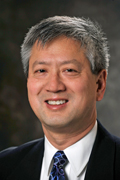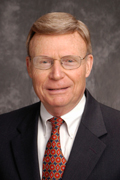News
2009 Technical Excellence Award Recipients
Tso Yee Fan
 For innovation in the solid-state laser field by demonstrating the first diode-pumped Yb laser and by pioneering both the use of cryogenics for scaling solid-state lasers to high power with excellent efficiency and techniques for laser beam combining.
For innovation in the solid-state laser field by demonstrating the first diode-pumped Yb laser and by pioneering both the use of cryogenics for scaling solid-state lasers to high power with excellent efficiency and techniques for laser beam combining.
Dr. Tso Yee (T.Y.) Fan is an Associate Leader in the Laser Technology and Applications Group at MIT Lincoln Laboratory. Currently, he is engaged in several programs primarily involved with advanced laser development, including efforts in high-power lasers using cryogenics and in laser-beam-combining techniques.
Dr. Fan joined Lincoln Laboratory in 1987 and has worked on a variety of laser and laser system development programs. He originally worked on the Optical Discrimination Technology program developing Q-switched Nd:YAG (neodymium-doped yttrium aluminum garnet) lasers for laser radar applications. As part of this work, he demonstrated the first diode-laser-pumped Yb:YAG (ytterbium-doped YAG) laser, which operated both at liquid nitrogen and room temperature. He recognized the potential for building efficient, high-average-power lasers by using cryogenic cooling of Yb-doped solid-state laser elements and did the first demonstration of such a laser in 1997. This work eventually led to the development at the Laboratory of the Enhanced Track Illuminator Laser, a laser system for the Airborne Laser, and to other efforts to build high-peak- and average-power laser systems. Dr. Fan has also led an effort to make measurements of key laser materials properties at cryogenic temperatures.
In the late 1990s and early 2000s, Dr. Fan was involved in research that was aimed at understanding approaches for beam combining large arrays of lasers. This research led to an understanding of the fundamental requirements for doing laser beam combining and to a demonstration of an array of 100 diode lasers being nearly ideally combined. Work continues on methods to combine even larger arrays of diode and fiber lasers. He has served in numerous positions for professional societies, including chair of the IEEE Laser and Electro-Optic Society's (LEOS) Annual Meeting and the Optical Society of America (OSA) Meeting on Advanced Solid-State Lasers, and member of the Board of Governors for IEEE LEOS. He has also been Topical Editor, Lasers, for the journal Optics Letters and the Division Editor, Lasers, Photonics, and Environmental Optics, for the journal Applied Optics. Dr. Fan is a Senior Member of IEEE and a Fellow of the OSA. He holds SBEE and SB degrees from the Massachusetts Institute of Technology and MS and PhD degrees from Stanford University.
Noted publications by T.Y. Fan
T.Y. Fan, D.J. Ripin, R.L. Aggarwal, J.R. Ochoa, B. Chann, M. Tilleman, and J. Spitzberg, "Cryogenic Yb3+-Doped Solid-State Lasers," invited paper, IEEE Journal of Selected Topics in Quantum Electronics, vol. 13, no. 3, pp. 448–459, 2007, © 2007 IEEE.
T.Y. Fan, "Laser Beam Combining for High-Power, High-Radiance Sources," invited paper, IEEE Journal of Selected Topics in Quantum Electronics, vol. 11, no. 3, pp. 567–577, 2005, © 2007 IEEE.
S.J. Augst, J.K. Ranka, T.Y. Fan, and A. Sanchez, "Beam Combining of Ytterbium Fiber Amplifiers," invited paper, Journal of the Optical Society of America B, vol. 24, no. 8, pp. 1707–1715, 2007, © 2007 Optical Society of America, Inc.
David R. McElroy
 For sustained contributions to the Department of Defense’s MILSATCOM program, for critical contributions to the nation’s communications priority, and for perfecting a method to transition Lincoln Laboratory technology to industry through the use of "gold standard" test instruments.
For sustained contributions to the Department of Defense’s MILSATCOM program, for critical contributions to the nation’s communications priority, and for perfecting a method to transition Lincoln Laboratory technology to industry through the use of "gold standard" test instruments.
Dr. David R. McElroy is the Leader of the Advanced Satcom Systems and Operations Group at MIT Lincoln Laboratory. Currently, he is engaged in the synthesis of innovative architectures for next-generation satellite communications (Satcom) systems, research into bandwidth-efficient signaling and resource allocation techniques for future protected Satcom and aerial relay communications systems, and design of an optical communications payload for satellite-based sensor platform readout.
Since joining the Laboratory in 1972, Dr. McElroy has been involved in the analysis and synthesis of communications and radar systems, as well as with the design, implementation, test, and technology transition associated with a variety of enabling Satcom technologies. He was the Laboratory's program manager for the Navy's Fleet Satcom EHF Package, an on-orbit proof-of-concept demonstration of technologies critical for the DoD's highly protected Milstar system. He directed the waveform development, prototyping, and establishment of a nationally deployed risk-reduction test infrastructure for the Advanced EHF Satcom system, which will replace Milstar. He coordinated the Laboratory's conceptual, prototyping, and end-to-end test infrastructure development for a potential generation-after-next wideband protected Satcom system, a cross-discipline effort leveraging optical, protected bandwidth-efficient signaling, and packet switching/routing technologies for a robust "Internet in the sky" capability.
Dr. McElroy has participated in projects sponsored by the Air Force, Army, Navy, Defense Advanced Research Projects Agency (DARPA), and other government agencies. He has served on Satcom architecture studies for the National Research Council, Office of the Secretary of Defense, DARPA, and U.S. Air Force. He has been a member of NASA's Space Systems and Technology Advisory Committee and has chaired the American Institute of Aeronautics and Astronautics (AIAA) Technical Committee on Communications Systems. He is a member of the Military Communications Conference Board, which provides guidance and policies for the annual Military Communications Conference (MILCOM) sponsored by the IEEE and the Armed Forces Communications and Electronics Association, and has organized technical programs for several MILCOMs.
Prior to joining the Laboratory, Dr. McElroy was an officer in the U.S. Army, with one tour as a communications researcher at the Army Electronics Command at Ft. Monmouth, New Jersey, and one tour in Vietnam, for which he was awarded the Bronze Star. He holds BS, MS, and PhD degrees, all in electrical engineering, from the Georgia Institute of Technology.
top of page